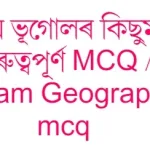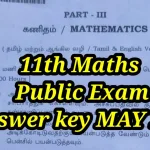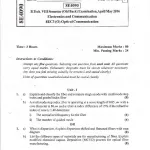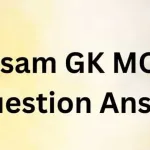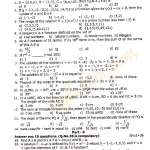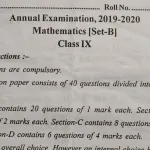Q: What is the significance of Bihu in Assamese culture? A: Bihu represents the set of three important non-religious festivals in Assam signifying the change in seasons and is a celebration of Assamese culture, involving dance, music, and feasting.
Q: Who is Lakshminath Bezbaroa? A: Lakshminath Bezbaroa was a celebrated Assamese author, poet, and playwright known as a pioneer of modern Assamese literature.
Q: Explain the main theme of the poem “Bon Kunwori” by Navakanta Barua. A: “Bon Kunwori” explores the theme of nature’s beauty and serenity, reflecting on how it influences human emotions and thoughts.
Q: What is the story “Monikut” about? A: “Monikut” is a touching story that highlights the importance of family bonds and cultural traditions, focusing on the life of an elderly couple in a rural Assamese village.
Q: Describe the character of Joymoti in Assamese folklore. A: Joymoti was a legendary Assamese princess known for her bravery and sacrifice. She endured torture and gave her life to protect her husband during political turmoil.
Q: What role does the Brahmaputra river play in Assamese literature? A: The Brahmaputra river is often depicted as a life-giving force in Assamese literature, symbolizing both the beauty and the wrath of nature, shaping the livelihoods and stories of the people living along its banks.
Q: Discuss the impact of Ananda Chandra Agarwala on Assamese literature. A: Ananda Chandra Agarwala was a prominent figure in Assamese literature, known for his contributions to poetry and prose that reflect Assamese society and cultural values.
Q: What is the literary significance of “Axomiya Bhaxar Unnati” by Hem Chandra Goswami? A: This work is significant for its detailed exploration of the evolution and development of the Assamese language and literature, encouraging linguistic pride and cultural identity.
Q: How does Assamese folklore influence modern Assamese literature? A: Assamese folklore, with its rich tapestry of myths, legends, and folktales, significantly influences modern literature by providing themes of heritage, moral lessons, and cultural context.
Q: Explain the cultural context of marriage rituals in Assamese literature. A: Marriage rituals in Assamese literature often depict the synthesis of traditional values and societal expectations, showcasing the rituals, ceremonies, and the deep-rooted cultural ethos of Assam.
Q: What does the short story “Dhouli” by Birendra Kumar Bhattacharya portray? A: “Dhouli” portrays the struggles and resilience of a young woman against social injustices and personal turmoil in rural Assam.
Q: Who is Jyoti Prasad Agarwala and what is his contribution to Assamese culture? A: Jyoti Prasad Agarwala was a legendary playwright, poet, and filmmaker who played a crucial role in the cultural renaissance of Assam, particularly through his works in Assamese cinema and theatre.
Q: Describe the significance of traditional Assamese jewelry in cultural expressions. A: Traditional Assamese jewelry, like the Jonbiri and Thuria, is not only an expression of aesthetic beauty but also a representation of cultural identity and heritage, frequently referenced in literature and celebrations.
Q: What are the primary themes in the poetry of Nilmani Phookan? A: Nilmani Phookan’s poetry often revolves around themes of existentialism, human relationship with nature, and socio-political commentary, reflecting deep philosophical insights.
Q: Explain the role of nature in Assamese songs. A: In Assamese songs, nature is often portrayed as a companion and a muse, inspiring poets and songwriters to express emotions ranging from love and longing to joy and sorrow.
Q: Discuss the narrative style of “Kamala Kunwori” by Rajanikanta Bordoloi. A: “Kamala Kunwori” utilizes a narrative style that combines historical storytelling with rich descriptions of Assamese society and customs, providing readers with a deep understanding of 19th-century Assam.
Q: What is the importance of the Assamese New Year in local literature? A: The Assamese New Year, or Rongali Bihu, holds great importance in literature as it symbolizes renewal and rebirth, often used as a backdrop for stories of hope, new beginnings, and community celebrations.
Q: How does modern Assamese literature address global issues? A: Modern Assamese literature addresses global issues by integrating local narratives with universal themes such as globalization, environmental concerns, and human rights, reflecting a contemporary Assamese perspective.
Q: What is the role of folklore in preserving Assamese language? A: Folklore plays a crucial role in preserving the Assamese language by keeping alive the oral traditions, proverbs, and stories that are passed down through generations, maintaining the language’s vibrancy and richness.
Q: Describe the influence of Sankardev on Assamese cultural life. A: Sankardev was a scholar, religious leader, and cultural icon whose works and teachings laid the foundation for Assamese culture, influencing everything from religion and music to theater and dance.
Q: How is the theme of love depicted in Assamese traditional songs? A: In traditional Assamese songs, love is depicted as a profound, often spiritual experience, intertwined with nature and expressed through poetic imagery and heartfelt melodies.
Q: What impact did Bishnu Rabha have on Assamese arts and literature? A: Bishnu Rabha, known as Kala Guru, significantly impacted Assamese arts and literature by promoting folk traditions, advocating social reforms, and enriching the cultural landscape through his multifaceted works.
Q: Explain the portrayal of village life in Assamese literature. A: Village life in Assamese literature is often portrayed with a focus on community interactions, traditional practices, and the challenges and joys of rural living, offering insights into the backbone of Assamese culture.
Q: Discuss the significance of the Assamese language movement in literature. A: The Assamese language movement played a pivotal role in literature by fostering a renewed interest in Assamese identity, leading to a resurgence in literary works that celebrate and promote the language.
Q: What are the common motifs found in Assamese mythology? A: Common motifs in Assamese mythology include the serpent, the river, and the tiger, symbols that represent the natural environment of Assam and its spiritual beliefs.
Q: How does Assamese literature reflect the socio-political landscape of Assam? A: Assamese literature often reflects the socio-political landscape by addressing issues such as ethnic diversity, political unrest, and social changes, providing a literary mirror to the state’s dynamic history.
Q: Describe the evolution of Assamese drama over the decades. A: Assamese drama has evolved from traditional plays influenced by religious themes to modern dramas that address contemporary issues, showcasing a shift from mythological narratives to more realistic and topical subjects.
Q: What is the role of festivals in Assamese literary works? A: Festivals in Assamese literary works are depicted as times of community bonding and cultural reflection, serving as settings for narratives that explore human relationships and societal values.
Q: How does Assamese poetry use symbolism to convey messages? A: Assamese poetry frequently employs symbolism, using elements like rivers, mountains, and local flora to convey deeper messages about life, culture, and identity.
Q: What is the significance of the tea gardens in Assamese literature? A: Tea gardens are significant in Assamese literature as they represent both the economic backbone of the region and the site of cultural and social intermingling, often depicted as spaces of conflict and cooperation.
Q: Discuss the influence of global literature on Assamese writers. A: Global literature has influenced Assamese writers by introducing new literary techniques and themes, which have been adapted to fit the local context, enriching Assamese literary expression.
Q: How are women portrayed in modern Assamese stories? A: In modern Assamese stories, women are often portrayed as central figures navigating through social norms and personal aspirations, reflecting the changing roles and status of women in society.
Q: What are the challenges faced by contemporary Assamese poets? A: Contemporary Assamese poets face challenges such as the diminishing readership, the need for linguistic innovation, and the struggle to maintain cultural relevance in a rapidly globalizing world.
Q: How do Assamese writers use folklore to address contemporary issues? A: Assamese writers use folklore to address contemporary issues by drawing parallels between traditional tales and modern challenges, using age-old wisdom to comment on and critique current societal trends.
Q: Describe the role of the Assamese diaspora in the global spread of its literature. A: The Assamese diaspora plays a crucial role in the global spread of its literature by translating works into other languages, sharing cultural stories and themes with international audiences, and fostering cross-cultural dialogue.
Q: What themes dominate the short stories of Indira Goswami? A: Indira Goswami’s short stories are dominated by themes of female empowerment, social injustice, and the complexities of human relationships, often set against the backdrop of Assamese society.
Q: How is the Brahmaputra depicted in Assamese poetry? A: In Assamese poetry, the Brahmaputra is often depicted as a powerful and nurturing presence, a source of both inspiration and devastation, reflecting the dual nature of this great river.
Q: What role does the Assamese script play in preserving language and culture? A: The Assamese script plays a fundamental role in preserving the language and culture by maintaining the unique phonetic and grammatical features of Assamese, serving as a key tool for cultural expression and identity.
Q: Discuss the evolution of Assamese novels from the 20th century to the present. A: Assamese novels have evolved from primarily focusing on social and political themes to exploring personal and psychological dimensions of characters, reflecting broader changes in society and the influence of global literary trends.
Q: How does Assamese literature explore the theme of migration? A: Assamese literature explores migration through narratives that highlight the emotional and social impacts of moving, whether within India or abroad, focusing on the themes of identity, loss, and adaptation.
Q: What is the significance of traditional Assamese costumes in cultural narratives? A: Traditional Assamese costumes, such as the Mekhela Chador, are significant in cultural narratives as symbols of Assamese identity and pride, often used in literature to depict cultural celebrations and rites of passage.
Q: How do Assamese authors depict the relationship between humans and wildlife? A: Assamese authors often depict the relationship between humans and wildlife as integral and complex, reflecting coexistence and conflict, influenced by Assam’s rich biodiversity and conservation challenges.
Q: What are the philosophical underpinnings in the works of Atul Chandra Hazarika? A: Atul Chandra Hazarika’s works often contain philosophical underpinnings that explore themes of human existence, morality, and the quest for meaning within the cultural and spiritual context of Assam.
Q: How is the festival of Magh Bihu depicted in Assamese literature? A: Magh Bihu is depicted in Assamese literature as a time of communal joy and feasting, symbolizing the end of the harvesting season and the abundance of Assam’s agrarian culture.
Q: What impact does Assamese music have on its poetry? A: Assamese music deeply impacts its poetry by influencing rhythmic structures, lyrical content, and emotional expression, creating a lyrical fusion that reflects Assamese cultural aesthetics.
Q: Describe the contribution of Syed Abdul Malik to Assamese literature. A: Syed Abdul Malik made significant contributions to Assamese literature through his novels and short stories that vividly portray rural and urban Assamese life, focusing on human values and social change.
Q: How does Assamese literature portray the theme of community? A: Assamese literature portrays the theme of community as a central element, exploring how collective experiences and cultural practices shape individual identities and social cohesion.
These questions and answers provide a broad spectrum of understanding, suitable for educational content or a resource aimed at students of Assamese literature in class 9.
Essential Books for Class 9 Assamese: Guides and Literature
- “Assamese Language and Literature” by Dr. Nagen Saikia (Sahitya Akademi Publications)
- Focuses on the development of Assamese language and includes exercises on prose, poetry analysis, and composition.
- “Bihu: A Comprehensive Study” by Dr. Ananda Bormudoi (Banphool Publications)
- Offers insights into the Bihu festival with descriptive answers about its cultural significance and practices.
- “Madhupur” by Rita Choudhury (Purbanchal Prakash)
- A collection of essays and stories ideal for comprehension and essay writing exercises related to Assamese culture and history.
- “Sankardev: Life and Philosophy” by Dr. Sanjib Kumar Borkakoti (Lawyers Book Stall)
- Discusses the life of Sankardev and his contributions to Assamese culture, including extracts for detailed study and questions for discussion.
- “Assamese Folk Tales” by Indira Goswami (Student’s Store)
- A compilation of folk tales that include questions on morals, themes, and cultural context, suitable for developing analytical skills.
- “Auniati Hem Barua” by Hem Barua (Bina Library)
- A primer on classical Assamese poetry with exercises on poetic devices, interpretation, and thematic discussions.
- “Assamese Grammar for Beginners” by K. K. Handique (Jyoti Prakashan)
- Covers foundational grammar topics with practice questions aimed at improving language skills.
- “Jyoti Prasad Agarwala: His Life and Works” by Hiren Gohain (Ananda Publishers)
- Biographical and analytical texts on Jyoti Prasad Agarwala’s contributions with targeted questions on his plays and poems.
- “Modern Assamese Literature” by Dhruba Jyoti Borah (Spectrum Publications)
- Explores the evolution of modern literature in Assam, with chapter-wise questions on key authors and literary trends.
- “Assamese Short Stories” by Birendra Kumar Bhattacharya (Publication Board Assam)
- Features a selection of notable short stories, each accompanied by comprehension questions and themes for essays.
- “Rabha Folklore and Cultural Study” by Bimal Rabha (Educreation Publishing)
- Focuses on Rabha tribal culture through folklore, providing questions that explore cultural anthropology and ethnographic studies.
- “Assam’s History and Culture” by Kanak Lal Barua (Lawyers Book Stall)
- Provides an overview of Assam’s historical milestones with related questions on social and political changes.
- “Lakshminath Bezbaroa: Comprehensive Works” by Maheswar Neog (Assam Book Depot)
- A detailed look at Bezbaroa’s literary works, suitable for advanced study of language, style, and narrative techniques.
- “Environmental Studies in Assam” by Arup Kumar Dutta (Educreation Publishing)
- Discusses Assam’s biodiversity and environmental issues with exercises that enhance awareness and analytical thinking.
- “Assamese Women Writers” edited by Aparna Mahanta (Purbanchal Prakash)
- A collection of works by Assamese women writers, encouraging exploration of gender studies and literary criticism.
- “The Brahmaputra and Its Folklore” by Anupam Saikia (Banphool Publications)
- Focuses on the folklore surrounding the Brahmaputra River, with narrative analysis and questions on environmental themes.
- “Classical Assamese Drama” by Udayaditya Bharali (Chandra Prakash)
- An anthology of classical dramas with a focus on theatrical techniques and script analysis.
- “Assamese Poetry Through Ages” by Pradip Acharya (Bookbell Publications)
- Chronicles the evolution of Assamese poetry with excerpts and questions aimed at understanding poetic forms and themes.
- “Folk Music of Assam” by Bhupen Hazarika (Ananda Publishers)
- Offers an in-depth study of Assam’s folk music traditions with related questions on musical elements and cultural integration.
- “Introduction to Assamese Culture” by Homen Borgohain (Sahitya Akademi Publications)
- Provides a broad overview of the cultural elements of Assam with discussions on art, literature, and social customs.
Each of these books provides a range of questions and content that help students delve deeper into the subject matter, focusing on understanding, analysis, and appreciation of Assamese language and culture.
Class 9 Assamese Question Answer: সমাধানৰ দিশ আৰু প্ৰস্তুতিৰ পৰামৰ্শ
কক্ষা 9ৰ আসামীয়া পাঠ্যক্ৰম এক বিস্তৃত আৰু বৈচিত্ৰময় সংকলন য’ত ভাষা, সাহিত্য আৰু সংস্কৃতিৰ গভীৰ জ্ঞান লাভ কৰা হয়। এই শ্ৰেণীত শিক্ষার্থীসকলে আসামীয়া ভাষাৰ মৌলিক ধাৰণা, গদ্য, পদ্য আৰু ভাষাৰ ব্যাকৰণ বিষয়ক জ্ঞান লাভ কৰে। এই শ্ৰেণীৰ অধ্যয়নৰ উদ্দেশ্য হ’ল ভাষাটোৰ প্ৰতি গভীৰ অনুধাবন আৰু সৃজনশীল অভিব্যক্তি বৃদ্ধি কৰা।
আসামীয়া ভাষাত প্ৰশ্ন উত্তৰৰ পাঠ্যক্ৰম বিষয়বস্তু বিস্তাৰিতভাৱে গঠিত হৈছে। প্ৰশ্নোত্তৰ সংকলনে শিক্ষার্থীসকলক নিজ নিজ বিষয়ৰ ওপৰত গভীৰভাৱে চিন্তা কৰাৰ লগতে প্ৰশ্নৰ ধৰণ বুজিবলৈ সহায় কৰে। ইয়াৰ লগতে উত্তৰৰ বাবে নিৰ্দিষ্ট দিশনিৰ্দেশনা আৰু প্ৰণালী উপলব্ধ কৰা হয়।
ভাষা শিক্ষাৰ ক্ষেত্ৰত ব্যাকৰণ অত্যন্ত গুৰুত্বপূৰ্ণ অংশ। কক্ষা 9 আসামীয়া ভাষাৰ পাঠ্যক্ৰমত ব্যাকৰণৰ বিভিন্ন বিষয় যেনে সন্ধি, সমাস, কাৰক, বিশেষণ, বিশেষ্য আদি অন্তৰ্ভুক্ত কৰা হৈছে। এই বিষয়বোৰ বুজাবলৈ শিক্ষার্থীসকলে বিশেষ মনোযোগ দিয়া উচিত।
সাহিত্যৰ অধ্যয়নে শিক্ষার্থীসকলক আসামীয়া সাহিত্যৰ বিভিন্ন যুগ, ধাৰা আৰু প্ৰবৃত্তি সম্পৰ্কে অৱগত কৰায়। এই ক্ষেত্ৰত বিশিষ্ট লেখকসকলৰ গ্ৰন্থ, কবিতা, নাটক, গল্প ইত্যাদি পঢ়াৰ দ্বাৰা বিশ্লেষণ কৰা হয়।
কক্ষা 9ৰ প্ৰশ্ন উত্তৰ সংকলনত বিশেষ গুৰুত্ব দিয়া হয় পাঠকৰ বোধগম্যতা, প্ৰশ্নৰ ধৰণ আৰু উত্তৰ লিখাৰ কৌশল উন্নত কৰাৰ ওপৰত। এই প্ৰক্ৰিয়াটোৱে শিক্ষার্থীসকলক নিজৰ মতামত প্ৰকাশ কৰিবলৈ আৰু তাৎপৰ্যপূৰ্ণ উত্তৰ দিবলৈ উৎসাহিত কৰে।
শ্ৰেণী 9ৰ আসামীয়া প্ৰশ্ন উত্তৰৰ অধ্যয়নৰ মুখ্য উদ্দেশ্য হৈছে শিক্ষার্থীসকলক এক সুদৃঢ় ভাষিক আৰু সাহিত্যিক ভিত্তি প্ৰদান কৰা যাতে তেওঁলোকে আগন্তুক শ্ৰেণীসমূহত সহজেই প্ৰতিষ্ঠা লাভ কৰিব পাৰে।
FAQ for class 9 assamese question answer
প্ৰ: কক্ষা 9ৰ আসামীয়া প্ৰশ্নোত্তৰৰ বাবে ভাল পুথি কি কি? উ: আসামীয়া ভাষা আৰু সাহিত্য, বিহু: এক সমগ্ৰ অধ্যয়ন, মধুপুৰ, আৰু সংকৰদেৱ: জীৱন আৰু দৰ্শন আদি পুথি কক্ষা 9ৰ বাবে অতি উপযোগী।
প্ৰ: কক্ষা 9ৰ আসামীয়া ভাষাৰ প্ৰশ্নোত্তৰত কি ধৰণৰ প্ৰশ্ন থাকে? উ: এই শ্ৰেণীত সাধাৰণতে ভাষাৰ ব্যাকৰণ, সাহিত্যৰ বিশ্লেষণ, সৃজনশীল লেখনি, আৰু পাঠ বোধগম্যতা সম্পৰ্কীয় প্ৰশ্ন থাকে।
প্ৰ: কক্ষা 9ৰ আসামীয়া পাঠ্যক্ৰমত কি কি মুখ্য বিষয় অন্তৰ্ভুক্ত কৰা হৈছে? উ: কক্ষা 9ৰ আসামীয়া পাঠ্যক্ৰমত ব্যাকৰণ, সাহিত্য (গদ্য, পদ্য), সংস্কৃতিৰ অধ্যয়ন, আৰু প্ৰয়োগাত্মক ভাষা ব্যৱহাৰ অন্তৰ্ভুক্ত হৈছে।
প্ৰ: কক্ষা 9 আসামীয়া প্ৰশ্নোত্তৰৰ প্ৰস্তুতিৰ বাবে কি কি পদ্ধতি অনুসৰণ কৰা উচিত? উ: নিয়মিত পঢ়া, নোট তৈয়াৰি কৰা, পূৰ্বৰ প্ৰশ্নপত্ৰসমূহৰ অধ্যয়ন, গ্ৰুপ আলোচনা, আৰু শিক্ষকসকলৰ সৈতে সন্দেহ নিৰসন কৰা উচিত।
Latest Posts
- Step-by-step guide to download and apply for jee mains admit card 202
- Comprehensive 2025 government holidays and recruitment details for job seekers
- JEE Mains Admit Card 2025: Your Step-by-Step Guide to Downloading the Hall Ticket
- Everything You Need to Know About 2025 Government Holidays Recruitment
- Comprehensive Guide to rrb d group recruitment 2025 – Eligibility, Vacancies, and Application
- Detailed guide to nps trust recruitment 2025 vacancies, eligibility and apply process
- Comprehensive guide to hpcl recruitment 2025 notification, vacancies, and application process
- ignou bed admission 2025 complete recruitment guide with eligibility and process
- Comprehensive Guide to Indian Army Agniveer Recruitment 2025 Notification and Jobs
- Everything You Must Know About CBSE Board Exams 2025 Changes & New Rules

